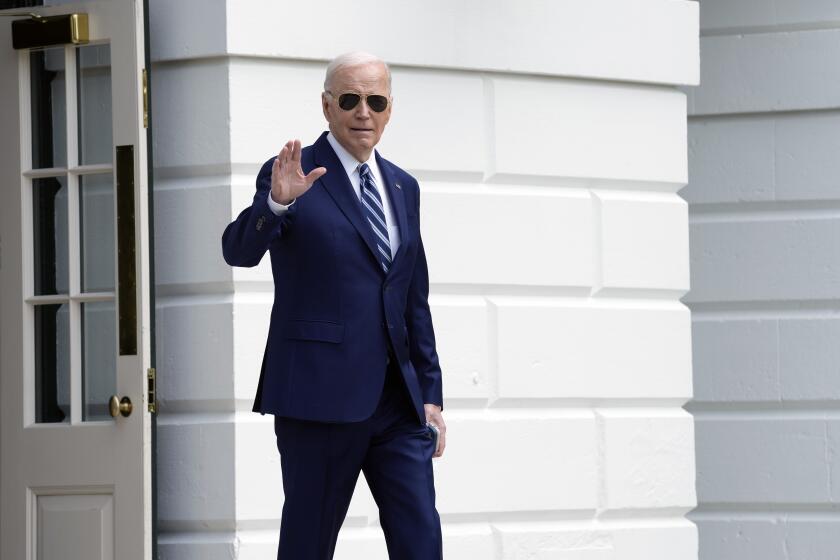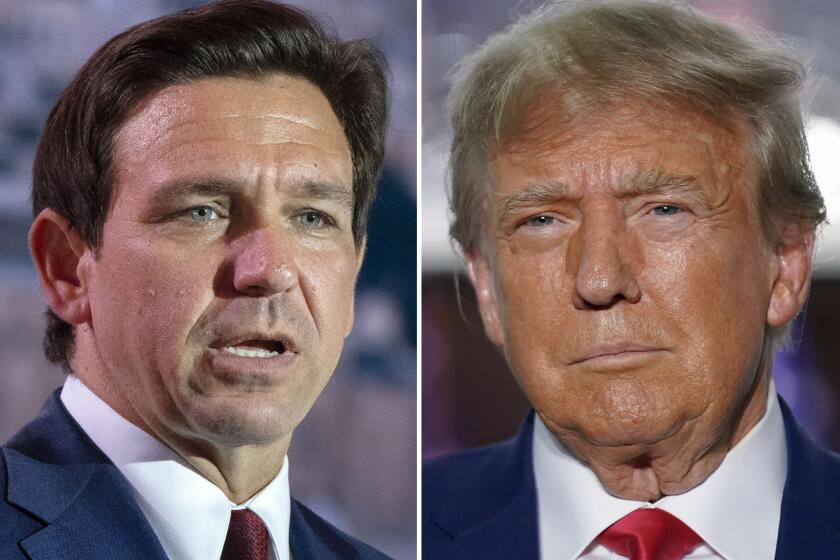U.S. Has Been Stockpiling Banned Pesticide
The United States has stockpiled millions of pounds of methyl bromide, a pesticide that depletes the ozone layer, according to newly public documents -- information that could create a stir during international negotiations next month, when the Bush administration seeks permission to produce more.
Methyl bromide has been banned for almost two years under the United Nations’ Montreal Protocol. Under that pact -- designed to stop the thinning of the ozone layer, which shields the planet from harmful ultraviolet radiation -- the United States is granted annual exemptions to use the chemical at farms that grow California strawberries, Florida tomatoes and other crops deemed “critical.”
The new Environmental Protection Agency data, which show that the stockpile is big enough to provide those farmers more than a year’s supply, are likely to put the Bush administration in the position of defending the size of the U.S. reserve while seeking approval for chemical companies to manufacture more.
In a negotiating process that already has been highly contentious, nations that ratified the U.N.’s 1987 treaty meet yearly to allocate how much methyl bromide each can use and produce. When the parties convene in New Delhi in late October to set 2008 allocations, it will be the first time they have had access to information about the size of the U.S. stockpile.
Under the treaty, nations are allowed to produce more only if “methyl bromide is not available in sufficient quantity and quality from existing stocks.”
In 2004, nearly 29 million pounds were stockpiled by U.S. chemical companies, but the Bush administration received permission from the United Nations to produce an additional 17 million pounds that year, according to newly released EPA data. That amounts to twice as much as U.S. farmers needed last year.
Last year, the inventory dropped to 22 million pounds, but an additional 15 million pounds were produced -- again totaling twice as much as farmers will use.
Methyl bromide, a highly toxic gas used to sterilize soil and kill pests, is considered the most powerful ozone destroyer currently in large-scale use. Scientists say the thinned ozone layer has increased the rate of skin cancers and cataracts, and has damaged ocean plankton, coral reefs and wildlife.
Environmental groups say the United States is hoarding tons of the chemical while convincing other U.N. countries that it must produce more every year. They say the stockpile should be reduced before new production is allowed or else its use will be prolonged.
“If we were following the treaty’s rules, we wouldn’t be producing any new material until the stockpile was drawn down. But for three years, the EPA has kept authorizing new production and adding to the stockpile,” said David D. Doniger, a policy director of the Natural Resources Defense Council, a national environmental group.
But Drusilla Hufford, director of the EPA’s stratospheric protection division, said an ample inventory was needed to provide a “cushion” to protect U.S. food growers from a “shock to the system” if production was interrupted.
The stock of methyl bromide, which has dropped 75% since 1991, continues to decline about 20% per year, which Hufford said allowed an “orderly reduction” as farmers and federal officials collaborated to find safer pest-killing alternatives.
“We need to have enough in the pipeline to ensure we don’t have a sudden shortage,” she said.
The EPA data also show for the first time that growers other than U.N.-designated “critical users” -- those whose market would be disrupted and that have no viable pest-killing alternatives -- are drawing from the U.S. stock.
U.S. tomato and strawberry growers and others deemed critical used 21 million pounds last year, but the total used exceeded 23 million pounds.
It is unknown which farms are using the 2.5 million pounds or what crops they grow. Because the stockpile was produced before the 2005 U.N. ban, EPA officials say, farmers can legally buy methyl bromide from chemical companies without seeking U.N. and EPA authority.
Chemtura Corp. of Middlebury, Conn., is the only U.S. methyl bromide producer. Its manager of fumigant product issues, David McAllister, said Wednesday that the stockpile was being “managed very responsibly” by the EPA and had dropped by nearly half in three years.
He said maintaining at least a year’s reserve was critical for agriculture in case “there were a catastrophic interruption in supply or some sort of pest infestation that was unanticipated.”
“Clearly if economically and technically viable alternatives were available, growers would be using them instead,” McAllister said.
The EPA’s Hufford said that unlike most countries, the U.S. agricultural sector was huge and diverse and faced a variety of pests, making its crops more vulnerable than those in the European Union and consequently more dependent on methyl bromide.
Methyl bromide, injected into soil, kills a broad spectrum of insects and diseases. It is used primarily on three high-value crops: strawberries, tomatoes and bell peppers. Florida is the largest user, followed by California, particularly Ventura and Santa Cruz counties.
In California, methyl bromide use declined 44% from 1994 to 2004. Growers of the state’s strawberries, a crop valued at more than $1 billion a year, have sought alternative pest controls since 1992, when the pesticide was added to the treaty.
U.S. farm groups and chemical companies have pressured the EPA for increased production, saying they worry about shortages.
Reacting to the new data, David R. Riggs of the Crop Protection Coalition, which represents 35 agricultural associations, said it was “arguable” whether the stockpile should be larger or smaller. But the most important fact, he said, is that it is getting considerably smaller every year.
“The EPA is driving down the inventories,” said Riggs, former president of the California Strawberry Commission. “We’re all phasing methyl bromide out. What we’re trying to do is balance the environmental issues with our ability to produce food in the U.S. and participate in international trade on a level playing field.”
But Doniger of the Natural Resources Defense Council said “there’s absolutely no justification for having a huge inventory” of an ozone-depleting chemical when the international pact says all nations “should have as little on hand as possible,” a couple of months’ worth.
The environmental group had sought the stockpile data through the Freedom of Information Act for two years; the EPA released it last week after chemical companies dropped lawsuits seeking to keep the data private.
“The EPA has hidden how much stockpile it’s had, so the other countries haven’t been in the position of saying, ‘You’ve got this stuff, you have to use it first,’ ” Doniger said.
Europe’s approach differs sharply from the U.S. government’s because it uses its existing stock before allowing more production.
Hufford said the EPA was glad that it could legally disclose the information. “The public certainly has a right to know about everything that affects the ozone layer,” she said.
The United States, by far the largest user, is seeking U.N. approval to use 14 million pounds of methyl bromide in 2008, about the size of its reserve projected for that year. The State Department leads the Bush administration’s negotiating team.
Acknowledging that the allocations have been “an extraordinarily difficult international issue for a number of years,” Hufford declined to comment on whether the size of the stockpile was likely to prompt cutbacks in the U.S. share.
Environmental activists worldwide have complained for years that the Bush administration is not being aggressive enough in scaling back methyl bromide and protecting the ozone layer.
In a report last month, scientists at the U.N. Environment Program and the World Meteorological Organization reported that the ozone layer was in worse shape than previously thought, and would take until 2065 to heal.
“Emissions associated with continued or expanded exemptions” of methyl bromide “may also delay recovery,” the scientists reported.
Hufford said the United States had made “enormous progress both in terms of monitoring its inventory and reducing its critical-use exemptions.”
*
(BEGIN TEXT OF INFOBOX)
Toxic chemical
Methyl bromide is an odorless gas that is injected into the soil in liquid form to kill insects and sterilize soil before the planting of strawberries, tomatoes and other crops.
Environmental concerns
Methyl bromide weakens the essential blanket of ozone in the “Earth’s atmosphere that helps keep out the sun’s” harmful ultraviolet rays.
---
The pesticide lingers in the air long enough for it to be transported by winds into the upper atmosphere, where it releases the bromine atoms that cause the ozone to decompose.
---
Global precautions
In 1992 the pesticide was added to the 1987 Montreal Protocol, an international agreement to gradually ban a variety of chemicals destroying the ozone barrier.
---
U.S. methyl bromide stockpile
(In millions of pounds*)
2003: 36.2
2004: 28.6
2005: 22.0
2006**: 19.2
---
U.S. exemptions
Despite the ban in 2005, the United Nations has given exemptions to the treaty for agricultural purposes deemed to be of “critical use.”
---
*As of year end **Projected
---
Sources: Environmental Protection Agency
Graphics reporting by John Jackson and Marla Cone
More to Read
Start your day right
Sign up for Essential California for news, features and recommendations from the L.A. Times and beyond in your inbox six days a week.
You may occasionally receive promotional content from the Los Angeles Times.






